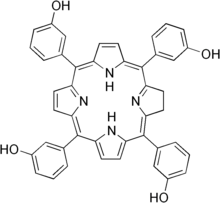This is the current revision of this page, as edited by OAbot (talk | contribs) at 10:42, 8 November 2023 (Open access bot: doi updated in citation with #oabot.). The present address (URL) is a permanent link to this version.
Revision as of 10:42, 8 November 2023 by OAbot (talk | contribs) (Open access bot: doi updated in citation with #oabot.)(diff) ← Previous revision | Latest revision (diff) | Newer revision → (diff) Chemical compound Pharmaceutical compound | |
| Clinical data | |
|---|---|
| AHFS/Drugs.com | International Drug Names |
| License data | |
| ATC code | |
| Legal status | |
| Legal status |
|
| Identifiers | |
IUPAC name
| |
| CAS Number | |
| PubChem CID | |
| ChemSpider | |
| UNII | |
| KEGG | |
| ChEMBL | |
| CompTox Dashboard (EPA) | |
| ECHA InfoCard | 100.152.970 |
| Chemical and physical data | |
| Formula | C44H32N4O4 |
| Molar mass | 680.764 g·mol |
| 3D model (JSmol) | |
SMILES
| |
InChI
| |
| (verify) | |
Temoporfin (INN) is a photosensitizer (based on chlorin) used in photodynamic therapy for the treatment of squamous cell carcinoma of the head and neck . It is marketed in the European Union under the brand name Foscan. The U.S. Food and Drug Administration (FDA) declined to approve Foscan in 2000. The EU approved its use in June 2001.
Good results were obtained in 21 of 35 patients treated in Germany.
It is photoactivated at 652 nm i.e. by red light.
Patients can remain photosensitive for several weeks after treatment.
References
- Lorenz KJ, Maier H (April 2008). "". Hno (in German). 56 (4): 402–409. doi:10.1007/s00106-007-1573-1. PMID 17516041.
- ^ O'Connor AE, Gallagher WM, Byrne AT (2009). "Porphyrin and nonporphyrin photosensitizers in oncology: preclinical and clinical advances in photodynamic therapy". Photochemistry and Photobiology. 85 (5): 1053–1074. doi:10.1111/j.1751-1097.2009.00585.x. PMID 19682322. S2CID 205950773.
- "Foscan approval saves Scotia's skin". HighBeam. Archived from the original on 2012-11-04.
- Lorenz KJ, Maier H (December 2009). "Photodynamic therapy with meta-tetrahydroxyphenylchlorin (Foscan) in the management of squamous cell carcinoma of the head and neck: experience with 35 patients". European Archives of Oto-Rhino-Laryngology. 266 (12): 1937–1944. doi:10.1007/s00405-009-0947-2. PMID 19290535. S2CID 5892034.
Further reading
- Marchal S, François A, Dumas D, Guillemin F, Bezdetnaya L (March 2007). "Relationship between subcellular localisation of Foscan and caspase activation in photosensitised MCF-7 cells". British Journal of Cancer. 96 (6): 944–51. doi:10.1038/sj.bjc.6603631. PMC 2360096. PMID 17325708.
This antineoplastic or immunomodulatory drug article is a stub. You can help Misplaced Pages by expanding it. |